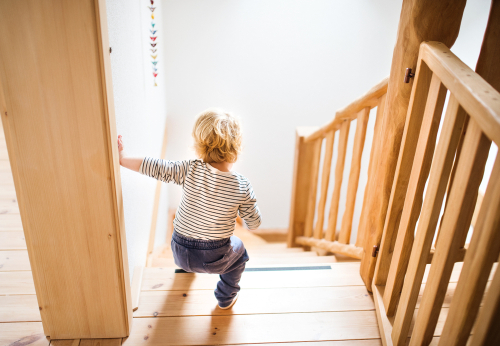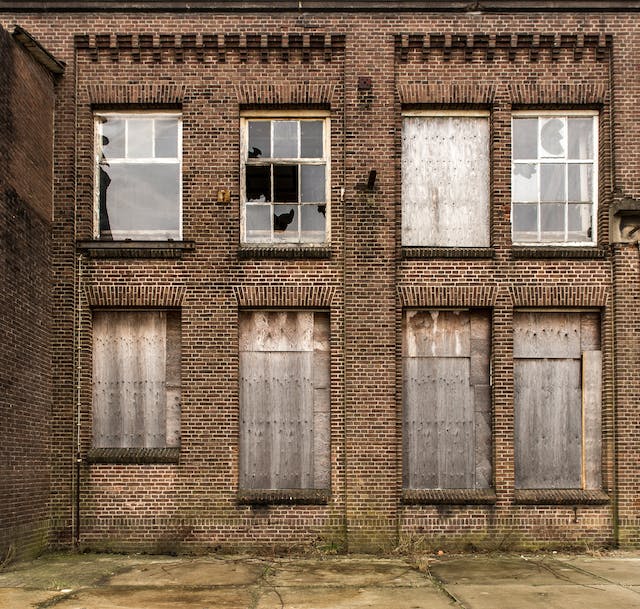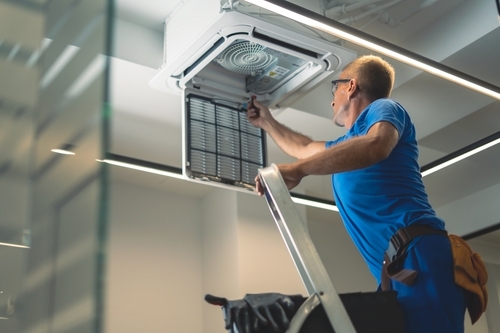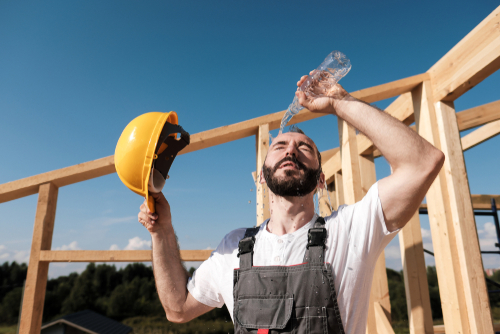Most of us who work in the pest control, building inspection and general property services sector are aware of the safety risks that come with entering customer premises, using chemicals, crawling into tight spaces and conducting other related tasks.
However, there are some safety risks that we don’t always think of or may not be trained to handle. This can include anything from protecting pets on a property to managing treatments at sensitive sites. These should be considered red flags that require quick thinking and immediate action on your part.
We’ve rounded up seven work-related red flags that can put you, your workers, or other people at risk.
1. Vulnerable people on site
A pest control technician recently shared on a Facebook group about an instance where he almost became an impromptu child sitter. His customer told him she needed to leave on an errand quickly and asked whether she could leave her young daughter home while he conducted his pest treatment.
If the technician had agreed, this would have put him in a hugely precarious position – both ethically and legally – if anything had happened to the child while he was there.
Before starting any sort of pest control treatment, make sure you’re fully informed of any people or animals on the site, especially children, the elderly, or those living with disability. And do not agree to any responsibilities outside those your job requires!

2. Structural issues and safety at work
Structural issues in a building can pose a huge risk to your safety at work. Aside from the obvious signs like cracks, sagging floors and broken beams, there are several red flags that show a building has structural flaws that could put you and your workers in danger. They include:
Doors and windows that stick or won’t close properly: If doors or windows are difficult to open or close, or they don’t fit in their frames like they used to, it could be due to the building shifting, which is a structural concern.
Gaps between walls and floors or ceilings: Visible gaps where the walls meet the floor or ceiling can indicate that the structure is shifting or settling in an uneven way.
Water damage: Water damage can lead to rot in wooden structures, especially in the foundation, beams, or roof. Look for signs of water stains, mould, or wood that feels soft or crumbly.
Pest infestations: As you’d be well aware, certain pests, like termites, can cause structural damage. Evidence of an infestation can be a red flag for hidden structural issues.

3. Dogs or other animals on the property
It’s vital that you’re aware of any dogs or other animals on a property before you conduct your pest management, building inspection, or general property services. There are two big reasons for this:
1. The safety of the animal
Some pest control treatments involve chemicals that could be harmful to animals if they come into contact with them. It’s vital that your customer makes you aware of pets in the vicinity before you conduct any sort of treatment. What would happen if their Doberman eats rat bait or their Siamese cat has an allergic reaction to carpet cleaner?
Always conduct a thorough risk assessment, follow a Safe Work Method Statement and ensure you use products approved by the Australian Pesticides and Veterinary Medicines Authority.
2. You and your employee’s safety
Pet behaviour can be unpredictable – this is especially the case for dogs and especially when strangers enter their territory. They can bark, jump, or even bite, which can be dangerous for you or your workers. Pets like dogs can also get in the way when you’re trying to do your job. They might follow you around, get into areas you’ve just treated, or even accidentally knock over equipment. This makes your work more difficult and less safe.
For this reason, always instruct your customer beforehand to keep their pets safely away from any areas where you’re carrying out your job activities.
Our 5 Tips For Pet Safety During Pest Control is a must-read for mixing pet safety and work.

4. Unrealistic expectations
A customer with unrealistic ideas of what you can and can’t do for them should be an immediate red flag. Not only because it could lead to disputes later on, but because an expectation to do a job in an unrealistic timeframe or under other challenging circumstances can put you and your workers at risk.
This often happens because property owners or residents don’t fully understand the complexities of pest control, building maintenance, landscaping, cleaning, and so on. Here’s how to not only educate them, but ensure they know exactly what to expect:
Clear communication: Start by clearly explaining what you can and can’t do, verbally and in writing. For instance, if you’re in pest control and it’s a complicated job, let them know that it might take several treatments to fully deal with an infestation and set up a management plan, and how some pests are harder to get rid of than others. In the building inspection game? You might want to read about read about how to report on pre purchase building inspection limitations.
Detailed information: Take the time to comprehensively explain the job completion process to them, why certain steps are necessary, and how long things usually take.
Set realistic timeframes: Give them an honest estimate of how long a job will take. It’s better to be upfront about potential delays or complications than to promise a quick fix that isn’t possible.
Provide regular updates: Keep them informed about what you’re doing and any changes in the plan. This helps manage their expectations and builds trust.
Be honest about costs: Talk to them upfront and openly about the costs involved and let them know immediately if you see a reason for these to rise above your quote. Avoid hidden charges as they can lead to unhappy customers.
Listen to their concerns: Sometimes, customers just want to be heard. Listen to their worries and address them as best as you can.
Follow-up: After completing a job, check in with your customers to see if they’re satisfied and to answer any questions they might have.
Our “How To Help Customers Prepare For A Pest Control Visit – Before And After Care” guide may help in mitigating unrealistic customer expectations.

5. Sensitive sites
Working close to sensitive sites is certainly a red flag, especially when it comes to pest management. In some parts of Australia, certain buildings are legally labelled “sensitive sites.” If you’re required to conduct a pest control treatment close to these sites, special steps needs to be taken. These sites include:
- Schools or pre-schools
- Childcare centres
- Hospitals
- Community health centres
- Nursing homes
If you’re within 20 metres of the border of a sensitive site, you legally need to provide at least five working days’ advance notice that you’ll be conducting a pest control treatment close to them.
This rule applies to outdoor spraying of pesticides as well as outdoor injection of liquid pesticides into the ground. You don’t have to give notice of other sorts of pesticide use such as use of solid baits or indoor treatments on adjoining properties.
Though only the buildings listed above are considered sensitive sites, it’s good practice to give notice when sensitive people are located nearby, such as before you spray a house next door to a park adjacent to a hospital (which would be used by patients/or and their families).

6. Ventilation for safety at work
Poor ventilation is one of the more obvious work safety red flags. If the air inside a building doesn’t move around much, it can get full of dust, chemicals, or other harmful things. This is especially risky when you use pest control chemicals. Without enough fresh air, these chemicals can stay in the air and you, your workers or your customers might breathe them in in large quantities, which can pose serious health risks.
Buildings with poor ventilation can also become very humid., which can make mould grow. This is not only bad for the air quality but can make you and others sick, especially if you have allergies or asthma.
Another consideration for safety at work is that in a place with bad ventilation harmful gases like carbon monoxide can build up, which is dangerous because you can’t see or smell them yet they can make you very sick.
Properly assess the ventilation of a building, roof void or crawl space before attempting to access or perform maintenance there. Also check out our piece on How To Safely Access Roof Voids for more safety info.

7. Heat and safety at work
Heat is a red flag in more ways than one. In Australia, where temperatures can soar, especially during the summer months, it poses a significant personal safety hazard. High temperatures can lead to various health issues, particularly when you’re working outdoors or in non-air-conditioned environments.
Consider the weather before going out on any type of job – as one of the most common risks associated with heat is heat exhaustion. This happens when you’re out in the heat for a long time and don’t drink enough water. You might start feeling weak, dizzy, or sweaty. Your skin can feel cool even though it’s hot outside. If you don’t take care and cool down, this can turn into something worse called heat stroke. Heat stroke is serious and needs immediate medical help.
Also, when it’s hot, you might not think as clearly about your safety at work. This can be risky, especially if you’re handling chemicals for pest control or checking buildings for safety. Mistakes can happen more easily.
Another issue is dehydration. This is when your body loses more water than you’re drinking. It can make you feel tired, give you a headache, and make it hard to focus.
To stay safe in the heat it’s important to drink lots of water, take breaks in cool places, and try to do the hardest work when it’s cooler, like early in the morning or later in the afternoon. Wearing a hat and light clothes can also help. Remember, taking care of yourself in the heat is really important for doing your job well and staying healthy.

Protect yourself, protect your business
Being well aware of personal safety at work can keep you, your business and everyone else involved protected from harm. That said, accidents and misunderstandings can and do still happen.
If you don’t have professional indemnity insurance or general liability insurance, you could be liable for big payouts. These policies cover several crucial aspects that help reduce the risk of financial strain on your business and finances. Contact Rapid Solutions today to enquire about cost-effective cover tailored to your business.

